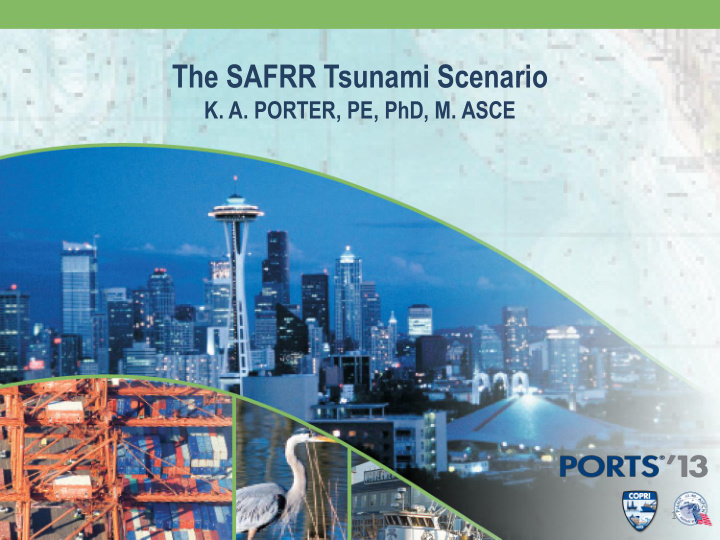



The SAFRR Tsunami Scenario K. A. PORTER, PE, PhD, M. ASCE 1
Coauthors L Jones, S Ross, J Borrero, J Bwarie, D Dykstra, EL Geist, L Johnson, S Kirby, K Long, P Lynett, K Miller, C Mortensen, S Perry, G Plumlee, C Real, L Ritchie, C Scawthorn, HK Thio, A Wein, P Whitmore, R Wilson, N Wood USGS, California Geological Survey, Cal Office of Emergency Services, and NOAA 2
Science Application for Risk Reduction SAFRR’s mission: innovate and apply hazard science for the safety, security, and economic well-being of the nation What is your science need? 3
SAFRR scenarios • A large but plausible event worth planning for • Crafted with stakeholders • Consensus among leading experts • Information for planning & mitigation decisions 4
Mw 9.1 offshore of Alaska Peninsula Like Tohoku rupture Between 1946 & 1964 sources Biggest contribution to LA’s tsunami hazard Hong Kie Thio URS Corp. 5
NOAA tsunami messages M8.6 11:54 AM Thu 27 Mar M8.2, Watch for CA M9.0 Warning for CA 12:00 PM Sat 29 March 6-21 hr duration (message 50): 2-5 ft at buoys Advisory cancelled for CA 8:02 PM Fri 28 March: 1 st wave @ Advisory for CA Crescent City Durations 24 hr San Francisco Amplitude ests San Pedro La Jolla 6
Hydraulic and hydrological modeling Waves up to 5m (15 ft) above MHHW at shore 1 st wave generally not the largest Independent models agree well 7
Physical damages chapter • Buildings, ports, marinas, roads, bridges, fire… • Describe asset, history, scenario damage, recovery, & resilience opportunities • Lean toward cautious (optimistically low) • Draw lessons from past tsunamis & H. Sandy • 32 peer reviewers – 2+ experts per topic – Professionals, scholars, stakeholder experts – Peer review was longer than the damage chapter 8
Marinas and harbors • 15% of boats sunk • 20% of boats damaged • 40% of docks damaged • 20% of docks destroyed • $700 million damage plus – Sediment transport “We don't think that a large – Hazmat tsunami would cause docks – Fires to float off the top of pilings, – Navigational hazards we KNOW that it will happen.” -- Morro Bay Harbor Director 9
Ports of Los Angeles and Long Beach 10
Ports of Los Angeles and Long Beach 8 kt 10 kt 8 kt 3½ hr warning 30-40 large vessels 8 kt Pilots remove 5-8 per hr 11-page dispersal plan – No specific triggers – Not exercised 11
Ports of Los Angeles and Long Beach 4 m/sec (8 kt) Guam: subs pulled from pier @ 2 kt 12
Ports of Los Angeles and Long Beach Tanks Liquid bulk Dry bulk 13
Ports of Los Angeles and Long Beach Moffatt & Nichol estimate: $100 M damage • 2,650 cars • 1,040 TEUs • Moorings, warehouses, equipment… • 2-3 days downtime Likely damage to other ports Port Elizabeth: PANYNJ “need to stay out of the habit of only reacting to the last event.” 14
Population vulnerability issues at the ports 7 7 7 4 4 6 7 6 5 State evacuation line 1 Tsunami scenario zone 5
Highways and bridges • Estimates created & reviewed with Caltrans • $100 million, mostly CA1, US101 road scour • Oakland-Bay Bridge Toll Plaza 16
Coastal homes & businesses Wetted • 13 counties, 1840 census blocks, 103 million sf (≈70,000 dwellings ), $31B value • 40% of property in Cal OES max inund. zone Repair cost • Using HAZUS (not “in” HAZUS) • $2.6B, mostly contents 17
Fuel + debris = fires • 284 in Tohoku • Here: 17 possible releases of flammable product • Pipe breaks, fires likely • POLA/LB: fire boats face strong currents 18
Economic bottom line: $5-10B Business interruption ($M) Repair Assets W/o resilience W/ resilience cost $M strategies strategies Ports of LA and LB $100 $4,300 $100-$860 Fishing in Port of LA $2 $0.3 Marinas and small craft $700 $30 Property damage $2,600 $1,700 $320 Roads and bridges $80 Railroads $2 Agriculture $4 Total (rounded) $3,500 $6,000 $420-$1,200 • Sediment, soil remediation, fires, other ports, and evacuation could add $1B+ • Reconstruction will bolster the economy 19
Potential environmental impacts • Toxicants in debris • Petroleum from refineries, terminals, & vessels • Dry bulk (industrial borates…) • Smoke, ash, debris from fires Port of Sendai March 2011 (EPA) • Contaminated sediments Westin Solutions 2009 20 Mercury in harbor sediments
Public policy • Federal and state tsunami-management policy is less developed than for other hazards • Risk awareness gaps (public & coastal sectors) may undermine disaster management in a big tsunami • Some maritime policy priorities: – More detailed analyses to identify high-hazard areas & safer facility & passageways locations – Port dispersal planning, training & exercise – Review regulations to facilitate port recovery and reduce BI, e.g., dredging 21
Cal OES Tsunami Program Inundation mapping Emergency response plans Maritime planning Land-use planning 22
Stakeholder survey & interviews 4 agencies, 37 respondents: • Found presenters well qualified, realistic scenario, well-thought-out findings • Using SAFRR info to improve preparedness • Understand tsunamis better, more able to plan • Improved networking, better understand other organizations Challenges • Info overload, organizational confidentiality 23
Conclusions • Realistic, worth planning for • Much more severe than 2010 & 2011 • CA lucky with tides in past tsunamis • Affects the entire CA coast: ports, marinas, communities, transit, tourism, … • Causes fires, hazmat, ecological damage • Resilience strategies can make a big difference • What are your science needs? 24
Learn more CA county emergency managers Workshops next 2 weeks throughout CA Open file report September 2013 http://www.usgs.gov/natural_hazards/safrr Keith.porter@colorado.edu 626-233-9758 25
Recommend
More recommend